Final report for LNE18-362
Project Information
Goldenberries (Physalis peruviana) are productive, nutritious annuals producing small, cherry sized fruit that taste like a mix of pineapple, strawberry, and sour cherry. Fruit are eaten raw, dried or made into jam or jelly. Goldenberries are widely grown in South America, South Africa and Australia, however, production guidelines for the US are non-existent due to the lack of a coordinated trial assessing readily available germplasm. This project conducted the first systematic evaluation of Physalis germplasm to identify genotypes with characteristics that make them well-suited for inclusion into CSAs and local farm markets. The project introduced growers to this new, unique fruit by providing seeds of several readily available genotypes along with general production recommendations. The project also developed a Sustainable Goldenberry Production Guide.
While most growers who tried goldenberries thought the fruit was worthy of further attention, our research established that goldenberry production in the northern US is difficult due to the long-season nature of the crop. While some growers were able to produce a marketable crop, many growers were unable to consistently bring a crop to market as frosts or freezes killed the plants before harvest. As such, many growers are reluctant to commit to larger scale production. Two hundred four growers evaluated goldenberries but only 10 intend to continue production. Growers generally plant between 50 and 100 plants per season which is approximately 0.02 to 0.04 acres each. More are likely to further evaluate production if methods are developed to induce earlier fruiting. We are going to pursue one possible solution: high tunnel production.
One hundred CSA/Farmers Market farmers adopt goldenberries as an annual fruit that easily fits their standard vegetable rotation as a solanaceous crop. Each farm produces and sells 50 pints per week for 6 weeks at $4 per pint on 0.25 acres each increasing total gate value by $120,000 per year.
Fruit is often not grown by CSA and farmers market growers due to their relatively small size and the long-term investment and greater input required for perennial and biennial fruit crops. Goldenberries (Physalis peruviana) are small, marble sized annual fruit native to South America with a tropical flavor that are eaten raw, made into jam or jelly, or dried. Goldenberries produce abundantly in temperate climates and fit standard crop rotations as a Solanaceous crop, however, guidelines for the US are non-existent and US production is minimal.
We have grown goldenberries for 4 years and have verified their production potential in this region. Our knowledge combined with production recommendations from South America produced the first Sustainable Goldenberry Production Guide for the US. We evaluated productivity of many genotypes along with production practices such as mulch color, pruning and training to identify germplasm suited for further evaluation. If growers adopted goldenberries, their farm income could increase without the major expense a traditional fruit crop incurs. We encouraged goldenberry production by CSA and farmers market growers of the Northeast by providing them germplasm, a Sustainable Goldenberry Production Guide and production updates via presentations at growers meetings.
Introduction of the goldenberry as an alternative annual fruit crop has provided growers a unique new crop to include in their production rotation. Unfortunately, due to the long-season nature of the crop, only 10 farmers have adopted goldenberries on a very limited basis in the Northeast.
Cooperators
Research
Given accurate production guidelines and correctly identified germplasm, growers in the Northeast will adopt
goldenberries as a fruit crop. In addition genetic improvement can be attained by identifying plant characteristics
which enhance productivity and developing superior cultivars utilizing traditional breeding methods.
2018
Experiment 1.
Invitations to participate in evaluating goldenberries as a new novel fruit were sent via e-mail in February 2018 to 2074 growers in the northeast region. Two hundred four growers ultimately participated in this study. Participating growers received two goldenberry genotypes to evaluate: 'Cape Gooseberry' from TradeWinds Fruit Company and 'Schoenbrunn Gold' from Turtle Tree Seed Company. Each grower received 25 seeds of each genotype and was provided instructions for production. Since commercial production of goldenberries is non-existent in North America, growers were provided estimates of best production practices based on information from South America. Growers were also provided an electronically delivered pdf of the 'Goldenberry Fact Sheet' (Fact Sheet Project LNE18-362) which was approved by SARE on 04/24/2018 by Candice Huber.
Growers were asked to grow 10 plants of each genotype and provide feedback regarding growth habit, ease of production, productivity and fruit quality.
Experiment 2.
Thirty globally sourced goldenberry genotypes (Table 1) were evaluated in a randomized complete block experiment replicated 10 times at Horticulture Farm 3 of the New Jersey Agricultural Experiment Station on Ryders Lane in East Brunswick, NJ during the 2018 growing season. Some of the selections evaluated were the same genotype acquired in different years from the same source, or open pollinated selections saved from previous acquisitions. Sources, year of acquisition and known pedigree history are presented in Table 1. Fruit were harvested and counted in early October and samples evaluated for fruit size, fruit color and production consistency regarding color and size. Production potential was estimated by multiplying the number of fruit produced per plant by the average fruit size obtained from samples. Color and production consistency were subjectively and visually evaluated by the principal investigator. Due to the nature of production (very long growing season, large planting, fruit maturation just prior to forecast hard freeze) not all plants of all genotypes were harvested, however, at least 5 plants per genotype were evaluated. Data were analyzed via an analysis of variance with mean separation performed using the REGWQ procedure when appropriate.
| Table 1. Goldenberry (Physalis peruviana) genotypes evaluated at Rutgers University during the 2018 growing season. |
|||
| Genotype | Source continent | Source and year sourced | Pedigree history |
| Cape Gooseberry | North America | Tradewinds Fruit - 2018 | Obtained 2018 |
| Schoenbrunn Gold | North America | Turtle Tree Seed - 2018 | Obtained 2018 |
| Cape Gooseberry | United Kingdom | Chiltern Seeds - 2018 | Obtained 2018 |
| Giant | United Kingdom | Chiltern Seeds - 2018 | Obtained 2018 |
| Tomatillo Ground Cherry | North America | Seed Needs - 2018 | Obtained 2018 |
| Ambrosia Husk Cherry | North America | Fedco Seeds - 2018 | Obtained 2018 |
| Poha Berry | North America | Maui Seed Company - 2018 | Obtained 2018 |
| Cape Gooseberry | North America | Floral Encounters - 2018 | Obtained 2018 |
| Giant Poha Berry | North America | Caribbean Garden Seed - 2018 | Obtained 2018 |
| Cape Gooseberry | Asia (Thailand) | Herbs4Health - 2018 | Obtained 2018 |
| Schoenbrunn Gold | North America | Turtle Tree Seed - 2016 | Obtained 2016, open pollinated at Rutgers 2016 |
| OP PI232077 64GI1 SD | South Africa | USDA ARS GRIN 2015 Geneva - 2015 | Obtained 2015, open pollinated at Rutgers 2015 |
| OP PI291561 95GI1 SD | India | USDA ARS GRIN 2015 Geneva - 2015 | Obtained 2015, open pollinated at Rutgers 2015 |
| Giant Cape Gooseberry | North America | Baker Creek Heirloom Seeds -2016 | Obtained 2016, open pollinated at Rutgers 2016 |
| Goldenberry | North America | Redwood Organic Seeds - 2016 | Obtained 2016, open pollinated at Rutgers 2016 |
| Golden Nugget | Australia | Cornucopia Seeds - 2016 | Obtained 2016, open pollinated at Rutgers 2016 |
| Golden Berry Gigante | United Kingdom | Plant World Seeds - 2016 | Obtained 2016, open pollinated at Rutgers 2016 |
| Cape Gooseberry | North America | Solana Seeds - 2016 | Obtained 2016, open pollinated at Rutgers 2016 |
| Schoenbrunn Gold | North America | Turtle Tree Seed - 2017 | Obtained 2017, planted 2018 |
| Goldenberry | North America | Strictly Medicinal - 2015 | Obtained 2015, open pollinated at Rutgers in 2015, 2016 |
| Cape Gooseberry | United Kingdom | Jungleseeds - 2016 | Obtained 2016, open pollinated at Rutgers 2016 |
| Cape Gooseberry | North America | Tree and Twig - 2016 | Obtained 2016, open pollinated at Rutgers 2016 |
| Golden Inca Berry | North America | The Rare Vegetable Seed Consortium - 2016 | Obtained 2016, open pollinated at Rutgers 2016 |
| Cape Gooseberry | North America | Rare Exotic Seeds - 2016 | Obtained 2016, open pollinated at Rutgers 2016 |
| Giant Cape Gooseberry | North America | Jakes Seeds - 2016 | Obtained 2016, open pollinated at Rutgers 2016 |
| Cape Gooseberry | North America | Tradewinds Fruit - 2016 | Obtained 2016, open pollinated at Rutgers 2016 |
| Navitas Raw Sun Dried Goldenberries | South America | Navitas Foods - 2016 | Seed extracted 2016, open pollinated at Rutgers 2016 |
| Navitas Raw Sun Dried Goldenberries | South America | Navitas Foods - 2016 | Seed extracted 2016, planted at Rutgers 2018 |
| Goldenberry | North America | Redwood Organic Seeds - 2016 | Obtained 2016, open pollinated at Rutgers 2016, 2017 |
| Cape Gooseberry | North America | Tradewinds Fruit - 2016 | Obtained 2016, open pollinated at Rutgers 2016, 2017 |
Experiment 3.
Two goldenberry lines (Cape Gooseberry, Tradewinds Fruit, and Schoenbrunn Gold, Turtle Tree Seed, both obtained in 2018) were evaluated in a field experiment replicated 5 times at Horticulture Farm 3 of the New Jersey Agricultural Experiment Station on Ryders Lane in East Brunswick, NJ during the 2018 growing season. The two genotypes evaluated in this experiment were selected based on observations from previous goldenberry trials at Rutgers. These two genotypes were also sent to growers for evaluation in experiment 1. Genotypes were evaluated on white and black plastic mulched raised beds, with or without trellising via a simple two wire trellis using T-stakes and heavy duty twine, with or without pruning to the first bifurcation of the main stem. The experimental design was a split-split-split plot with mulch color as main plot, trellising as sub-plot, genotype as sub-sub-plot and pruning as sub-sub-sub-plot. The experimental unit was a three-plant plot. Data collected from the middle plant in each plot was used in the data analysis. Fruit were harvested and counted in early October and samples evaluated for fruit size, fruit color and production consistency regarding color and size. Production potential was estimated by multiplying the number of fruit produced per plant by the average fruit size obtained from samples. Color and production consistency were subjectively and visually evaluated by the principal investigator. Due to the nature of production (very long growing season, large planting, fruit maturation just prior to forecast hard freeze) not all plants were harvested, however, at least 4 plants per treatment combination were evaluated. Data were analyzed via an analysis of variance and means separated via Fisher's Protected LSD, when appropriate.
2019
Experiment 1.
Growers who participated in the first year of evaluating goldenberries were invited via e-mail in February 2019 to participate again in 2019. Growers attending the small fruit / specialty crops sessions at The Mid-Atlantic Fruit and Vegetable Convention in Hershey, PA in January 2019 and the New Jersey Agricultural Convention and Trade Show in Atlantic City, in February 2019 were also invited to participate. A total of one hundred and thirty five growers chose to participate in 2019.
Participating growers received 50 seeds of 'Schoenbrunn Gold' from Turtle Tree Seed Company to evaluate and were provided instructions for production. A link to the pdf of the 'Goldenberry Fact Sheet' (Fact Sheet Project LNE18-362) was provided in the instructions. Growers were asked to grow 10 plants and provide feedback regarding growth habit, ease of production, productivity and fruit quality.
Experiment 2.
Eighteen globally sourced goldenberry genotypes (Table 2) were evaluated in a randomized complete block experiment replicated 6 times at Rutgers Fruit and Ornamental Research Center in Cream Ridge, NJ during the 2019 growing season. Sources and year of acquisition are presented in Table 2. After initial acquisition, seed lines were maintained by extracting seed from open pollinated fruit grown at Rutgers Horticultural Research Farm 3 in East Brunswick, NJ. Fruit in experiment 2 were harvested and counted in early October and samples evaluated for fruit size, fruit color and production consistency regarding color and size. Production potential was estimated by multiplying the number of fruit produced per plant by the average fruit size obtained from samples. Color and production consistency were subjectively and visually evaluated by the principal investigator. Due to the nature of production (very long growing season, large planting, fruit maturation just prior to forecast hard freeze) not all plants of all genotypes were harvested, however, at least 2 plants per genotype were evaluated. Data were analyzed via an analysis of variance with mean separation performed using the REGWQ procedure when appropriate.
|
Table 2. Goldenberry (Physalis peruviana) genotypes evaluated at Rutgers University during the 2019 growing season. |
|||
|
ID |
Genotype |
Source continent |
Source and year sourced |
|
BC-16-OP16-OP18 |
Giant Cape Gooseberry |
North America |
Baker Creek Heirloom Seeds – 2016 |
|
COL-DE-16-OP16-OP18 |
Navitas Raw Sun Dried Goldenberries |
South America (Columbia) |
Navitas Foods -2016 |
|
CS-16-OP16-OP18 |
Golden Nugget |
Australia |
Cornucopia Seeds – 2016 |
|
CS-1735C-18-OP18 |
Giant |
United Kingdom |
Chiltern Seeds - 2018 |
|
FS-4009D-18-OP18 |
Ambrosia Husk Cherry |
North America |
Fedco Seeds -2018 |
|
GRS-16-OP16-OP18 |
Golden Inca Berry |
North America |
The Rare Vegetable Seed Consortium – 2016 |
|
H4H-CG-18-OP18 |
Cape Gooseberry |
Asia (Thailand) |
Herbs4Health – 2018 |
|
IN-15-OP15-OP16-OP18 |
OP PI291561 95GI1 SD |
India |
USDA ARS GRIN 2015 Geneva |
|
J-2053-16-OP16-OP18 |
Cape Gooseberry |
United Kingdom |
Jungleseeds -2016 |
|
MS-18-OP18 |
Poha Berry |
North America |
Maui Seed Company - 2018 |
|
PWS-16-OP16-OP18 |
Golden Berry Gigante |
United Kindom |
Plant World Seeds -2016 |
|
RES-16-OP16-OP18 |
Cape Gooseberry |
North America |
Rare Exotic Seeds -2016 |
|
RWS-16-OP16-OP17-OP18 |
Goldenberry |
North America |
Redwood Organic Seeds - 2016 |
|
SA-15-OP15-OP16-OP18 |
OP PI232077 64GI1 SD |
South Africa |
USDA ARS GRIN 2015 Geneva |
|
SM-15-OP15-OP16-OP18 |
Goldenberry |
North America |
Strictly Medicinal – 2015 |
|
SS-16-OP16-OP18 |
Cape Gooseberry |
North America |
Solana Seeds – 2016 |
|
TT-SG-18-OP18 |
Schoenbrunn Gold |
North America |
Turtle Tree Seed – 2018 |
|
TW-10008-16-OP16-OP17-OP18 |
Cape Gooseberry |
North America |
Tradewinds Fruit – 2018 |
Experiment 3.
An experiment evaluating training system was aborted mid-season due to excessive plant growth. Since the work did not provide useful information, it is not included in this report.
2020
Despite restrictions in place due to the pandemic, 67 growers participated in our final year of trialing goldenberries as new crop for CSAs and Farmers Markets. Participating growers received 50 seeds of 'Schoenbrunn Gold' from Turtle Tree Seed Company to evaluate and were provided instructions for production. A link to the pdf of the 'Goldenberry Fact Sheet' (Fact Sheet Project LNE18-362) was also provided in the instructions. Growers were asked to grow 10 plants and provide feedback regarding growth habit, ease of production, productivity and fruit quality.
2018
Experiment 1.
Two hundred four growers participated in on-farm goldenberry evaluation in 2018. Thorough grower evaluation of the two genotypes was limited in that many growers reported that they did not harvest ripe fruit. Two major factors contributed to this: (1) the long growing season required by goldenberry and (2) many growers did not receive seed until mid-March or later. Notification of funding occurred in late February, thus seed purchasing, grower invitation e-mailing and seed shipment to growers was later than desired. Seed was shipped to participating growers in February 2019.
Submission of results from grower participants was limited (12 submissions). Comments from growers are provided below:
"In a hideous growing season, all the goldenberry plants always looked glorious!! Except for the potato bugs on early field transplants all varieties were disease free and very healthy looking. The smaller berries (identified by grower as 'Aunt Molly's' and 'Goldie' ground cherry) not part of the trial won the taste tests against any large berry (identified as T or S goldenberry) every time tested. Harvest of all large berry plants was cut short by frost. Plants were full of buds/fruit however, so a longer season than that of NE PA is indicated."
“We have noticed a fair bit of pressure from Colorado Potato Beetle but we are a no-spray farm which means we hand-pick bugs and have managed to keep it under control.”
“Germination rates from goldenberry seeds were low - about 80% of seeds germinated. Far lower than any tomato or ground cherry varieties. At transplant into black plastic drip irrigation beds, the 3 lined potato beetles and larvae were devastating. We used a combination of hand-picking to Surround WP, neem oil, and diatomaceous earth to fight through and the plants recovered and are growing, however flowering and fruits have still not set. When benchmarking versus the current goldie ground cherries, the golden berries are far healthier and currently outperforming the ground cherries in garden beds.”
“Cucumber beetles couldn’t wait to start in laying eggs. S looks sturdier than T, both look vibrant green and happy”
“the goldenberries seem to be an incredible trap crop! We have them planted in row with tomatillos, adjacent to eggplant, and where we would normally see Colorado Potato Beetle damage on all three, they are eating the goldenberries and leaving the rest alone. We are a no-spray farm, and the plants seem to respond very well to weekly foliar feedings to fill in where there has been insect damage. Despite some neglect on our part (especially during a few cold snaps where they were uncovered) the plants are healthy and thriving. Thanks for letting us be a part of the trial”
“Germination was fairly prompt (don't have exact date), much more so than husk cherries seeded on the same day. 'S' appears slightly more vigorous than 'T'. They recently jumped up in size with the heat after sulking for a while in the cool temps. We're excited about the trial, and are hoping we remember not to fertilize under the section of plastic where they will be planted. We may end up putting them in an unheated hoophouse.”
“Thank you for sharing these varieties. I have the following observations about the Goldenberries:
• Seed was sown May 10, 2018 and transplanted to the field on black plastic mulch with drip tape on June 5, 2018, as part of a larger Husk Cherry Trial.
• Plants grew well throughout the summer, reaching over five feet by mid-September. Plant growth was vigorous, and plants were wide and healthy, with very dark green leaves and little/no evidence of disease throughout the growing season.
• Fruit were very slow to ripen – September 10 was the first date for ripe fruit. Yield data was not collected as plants matured too late in the season. There seems to be a large amount of plant biomass relative to the amount of fruit produced, especially when compared to ground cherry varieties such as Goldie.
• Flavor got mixed reviews from tasters – some appreciated the unique flavor while others found it unpleasant.
• No significant differences were noted between the two Goldenberry strains for plant habit or flavor.
The slow maturity of the variety, along with the relatively lower yield compared to Husk Cherry were the main drawbacks of the variety.”
“October 3 first harvest, I didn’t taste any of them, was saving for seed. You can smell the ripe ones, even if the husk isn’t brown and lacy-looking.”
“The fruit on both varieties matured too late here in Maine to harvest the majority of the crop. The S variety had the pleasing orange color and the T variety was larger but greener (although very good flavor). Both varieties seemed difficult to harvest and it took a long time. They did not fall when ripe as tomatillos do and they are hard to see amongst dense foliage. However they were both delicious and I would like the research to continue addressing harvest dates, ease of picking.”
“Thanks for allowing us to participate in your goldenberry study. I did grow the plants out this past year and here are my results and assessment: I started all 50 seeds in trays on 3/27/18. On 5/25/18 I transplanted the 45 that germinated out to the field, spacing them about 4' apart in all directions. They were planted through black weed cloth. Along with ground cherries, these plants were the largest magnet of 3 striped potato beetle I've seen. We spent hours picking off larvae, egg masses and beetles more than one while the plants were still small. We also found several hornworms and were able to pick them off but not before some of them caused some real damage. They take quite a while to get any amount of fruit from them. The fruit I did get were tasty to me and a few others that I gave them too. Unfortunately the yields were quite low and I didn't have enough to give to our CSA. Sometimes the husk would be empty and the fruit eaten by some critter when I opened them up. We had a very wet 2nd half of the year with rain starting in mid July and never letting up for any appreciable amount of time. By the time first frost hit there were many fruit just starting to come in, way too long a time to ripen IMHO. Perhaps these plants worked better for other growers but for us we won't be growing them again. Our ground cherries are way more productive and we are able to offer our CSA them for many weeks during our main growing season.”
“Our plants got huge this year but yielded very little as they were really just ripening up when frost hit. They were planted on black plastic (not raised) and both varieties grew nearly 6’ tall and about 10’ wide. They didn’t really start setting many fruit until they were 4-5’ tall. Yields were negligible, only a few quarts of each variety on 30’ of each. Given that it was a crazy wet and awful growing season for many crops, I look forward to trying again next year. My physalis pruinosa produced well this year and were only slightly later than normal, but I did have some pepper varieties that similarly grew huge and didn’t set fruit until it was too late to mature most of it.”
“I want to let you know that the goldenberries that we trialed for you never made it to completion. The Aunt Mary's (?) that we also raised made a fantastic crop. Too long of a season for us.So, we need a shorter season variety for them to work for us. “
Based on general e-mail interactions with growers, many of them enjoyed participating in this work. Unfortunately many of them did not submit comments regarding field performance of the two lines we sent them. Perhaps it was the lack of productivity especially in more northern areas due to a late start and a poor to perhaps fair growing season. I think this might have discouraged many of the participants.
Experiment 2.
The number of fruit, average fruit weight and estimated potential yield per plant are presented in Table 3.
| Table 3. Number of fruit, average fruit weight and estimated production per plant for goldenberry genotypes evaluated at Rutgers University during the 2018 growing season. |
|||
| Fruit / plant | Fruit size | Estimated yield / plant | |
| Genotype | (number) | (g) | (g) |
| Cape Gooseberry - Tradewinds Fruit 2018 | 79 abcz | ----y | ----y |
| Schoenbrunn Gold - Turtle Tree Seed 2018 | 54 abc | ----y | ----y |
| Cape Gooseberry - Chiltern Seeds 2018 | ----x | ----x | ----x |
| Giant - Chiltern Seeds 2018 | 80 abc | 2.1 defgh | 167 abcde |
| Tomatillo Ground Cherry - Seed Needs 2018 | ----x | ----x | ----x |
| Ambrosia Husk Cherry - Fedco Seeds 2018 | 29 abc | 2.5 def | 73 bcde |
| Poha Berry - Maui Seed Company 2018 | 66 abc | 2.3 defgh | 152 bcde |
| Cape Gooseberry - Floral Encounters 2018 | 70 abc | 2.2 defgh | 155 abcde |
| Giant Poha Berry - Caribbean Garden Seed 2018 | ----x | ----x | ----x |
| Cape Gooseberry - Herbs4Health 2018 | 18 bc | 4.8 abc | 85 bcde |
| Schoenbrunn Gold Turtle Tree Seed 2016 OP 2016 | 48 abc | 5.5 ab | 262 abc |
| OP PI232077 64GI1 SD - USDA ARS GRIN 2015 - OP 2015 - OP 2016 | 134 a | 3.0 bcd | 402 ab |
| OP PI291561 95GI1 SD - USDA ARS GRIN 2015 - OP 2015 - OP 2016 | 81 abc | 3.1 bcd | 252 abcd |
| Giant Cape Gooseberry - Baker Creek Heirloom Seeds 2016 - OP 2016 | 84 abc | 2.2 defgh | 186 abcde |
| Goldenberry - Redwood Organic Seeds 2016 - OP 2016 | 50 abc | 2.4 defgh | 119 bcde |
| Golden Nugget - Cornucopia Seeds 2016 - OP 2016 | 66 abc | 2.7 cde | 179 abcde |
| Golden Berry Gigante - Plant World Seeds 2016 - OP 2016 | 44 abc | 2.4 def | 105 bcde |
| Cape Gooseberry -Solana Seeds 2016 - OP 2016 | 110 a | 6.9 a | 755 a |
| Schoenbrunn Gold -Turtle Tree Seed 2017 | 38 abc | 5.2 ab | 195 abcd |
| Goldenberry -Strictly Medicinal 2015 - OP 2015 - OP 2016 | 60 abc | 1.9 defgh | 113 bcde |
| Cape Gooseberry -Jungleseeds 2016 - OP 2016 | 82 ab | 2.1 defgh | 173 abcd |
| Cape Gooseberry -Tree and Twig 2016 - OP 2016 | 105 ab | 2.0 defgh | 209 abcd |
| Golden Inca Berry - The Rare Vegetable Seed Consortium 2016 - OP 2016 | 106 ab | 2.4 defg | 254 abc |
| Cape Gooseberry - Rare Exotic Seeds 2016 - OP 2016 | 107 a | 2.1 defgh | 224 abc |
| Giant Cape Gooseberry - Jakes Seeds 2016 - OP 2016 | 105 a | 2.5 def | 263 abc |
| Cape Gooseberry - Tradewinds Fruit 2016 - OP 2016 | 38 abc | 1.6 fgh | 61 cde |
| Navitas Raw Sun Dried Goldenberries Extracted 2016 - OP 2016 | 64 abc | 1.7 efgh | 108 bcde |
| Navitas Raw Sun Dried Goldenberries Extracted 2016 | 108 ab | 2.4 def | 259 abcd |
| Goldenberry - Redwood Organic Seeds 2016 - OP 2016 - OP 2017 | 9 c | 1.3 gh | 12 e |
| Cape Gooseberry - Tradewinds Fruit 2016 - OP 2016 - OP 2017 | 26 abc | 1.3 h | 34 de |
|
zMean separation via REGWQ test, ∝ = 0.05. yFruit size not measured in Experiment 1 / yield not estimated. xNot goldenberry. |
|||
Three of the 30 genotypes evaluated were not goldenberries (Table 3). They were ground cherries.
Variability among goldenberry genotypes was limited with respect to fruit size, number produced per plant and estimated yield. Two fruiting 'types' could be discerned among the 27 goldenberry lines evaluated: (1) genotypes producing smaller, marble sized and shaped fruit weighing approximately 2 - 3 g each and (2) genotypes producing larger, more irregularly shaped fruit weighing 5 - 6 g each. The average number of fruit per plant ranged from 9 to 134 and smaller fruited genotypes generally tended to produce more fruit per plant compared to larger fruited genotypes. Yield per plant ranged from as low as 50 g per plant (~0.1 lb) to as high as 756 g per plant (1.6 lbs per plant).
These yields are exceptionally low based on an evaluation of similar germplasm in 2017 which produced from 300 to 2,000 g per plant (0.6 to 4.4 lbs per plant). The average fruit size in 2017 was approximately 4 g per fruit for the smaller fruited genotypes and 9 g per fruit for the larger fruited types. In 2017 fruit number per plant varied from an average of 67 to 516 fruit per plant depending on genotype.
Based on personal observation and impromptu evaluations by visitors to the farm, the larger fruited genotypes had a more fruit-like, tropical flavor compared to the smaller fruited genotypes which often had a background bitter flavor. The bitter flavor did not make the smaller fruited genotypes undesirable, it was simply a discernible flavor characteristic. However, the larger fruited genotypes received more favorable comments than the smaller fruited genotypes with respect to desirability.
Several of the genotypes exhibited exceptionally consistent and attractive fruit shape and color (golden yellow/orange). The two most desirable genotypes were (1) Golden Inca Berry - The Rare Vegetable Seed Consortium (no longer available from original source) and (2) Cape Gooseberry - Rare Exotic Seeds 2016 (still available from source, December 2018). Four other genotypes were attractive and well-colored, but they were not as nice as the two previously mentioned genotypes: (1) OP PI232077 64GI1 SD - USDA ARS GRIN 2015 - OP 2015 - OP 2016, (2) OP PI291561 95GI1 SD - USDA ARS GRIN 2015 - OP 2015 - OP 2016, (3) Giant Cape Gooseberry - Baker Creek Heirloom Seeds 2016 - OP 2016, and (4) Cape Gooseberry - Herbs4Health 2018.
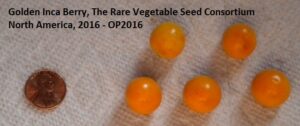
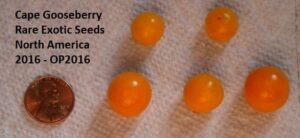
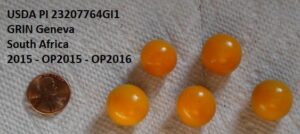
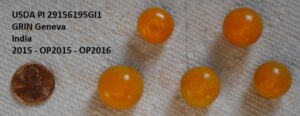
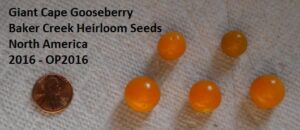
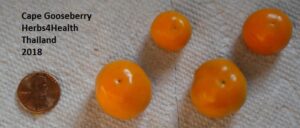
Genotypes producing inconsistently colored fruit are presented below for comparison. Note the variation in fruit color, size and general appearance.
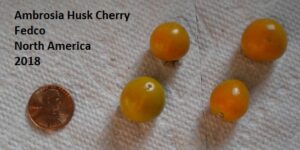
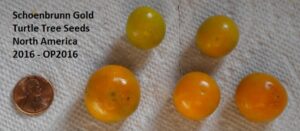
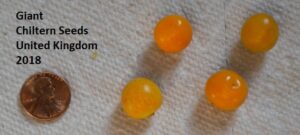
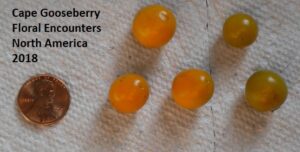
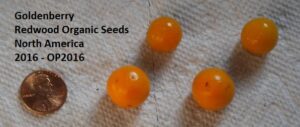
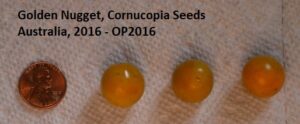
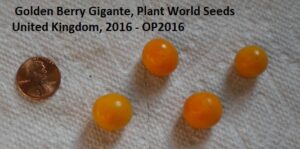
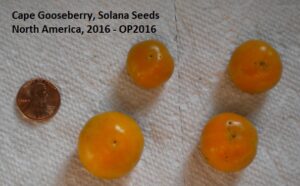
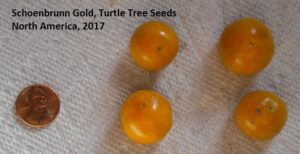
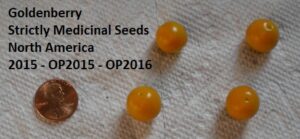
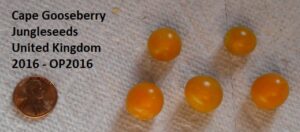
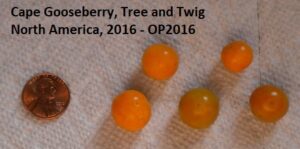
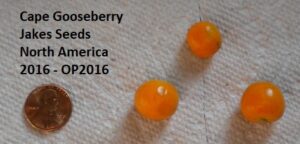
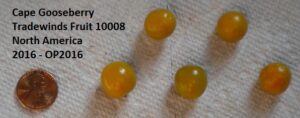
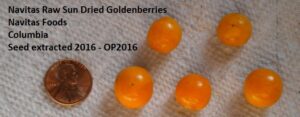

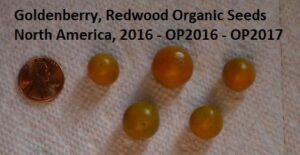
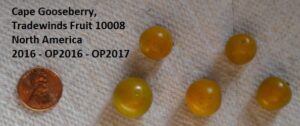
Even though one of the most highly colored and consistent genotypes is no longer available from the original source, we have saved seed from each line, which are essentially inbred lines since goldenberries do not cross easily. Thus genetic material is available for crop improvement.
The 2018 growing season in the Mid-Atlantic and Northeast regions was exceptionally wet, with frequent rain and significant temperature fluctuations. Overall, the growing season was considered fair / poor with respect to crop productivity.
Experiment 3.
The number of fruit produced per plant, the average fruit size (g) and the estimated yield per plant (fruit number X average fruit size) were evaluated via an analysis of variance considering the split-split-split plot design. Treatment means were separated using Fisher's Protected LSD when appropriate.
Fruit per plant
A significant genotype X pruning interaction was detected for the number of fruit produced per plant.
| Table 4. The average number of fruit produced per plant for two goldenberry genotypes grown on white or black plastic mulch, with or without trellising, with or without pruning. | ||
| Genotype | Pruned | Not pruned |
| Tradewinds Fruit | 213 bz | 250 a |
| Schoenbrunn Gold | 119 a | 82 a |
| zMean separation within row by Fisher's Protected LSD, ∝ = 0.05 | ||
Pruning the Tradewinds Fruit genotype reduced the number of fruit produced per plant while pruning Schoenbrunn Gold had no effect on fruit number. Pruning, which consisted of removing all suckers and shoots below the first bifurcation of the main stem, may have altered the vegetative / floral balance of the smaller fruited genotype or simply removed potentially flowering shoots from the plants.
Neither mulch color nor trellising affected the number of fruit produced per plant.
Fruit Size
A significant mulch color X trellising X genotype X pruning interaction (∝ = 0.02) was detected for average berry weight. To elucidate the trellising, genotype and pruning effects a separate analysis was performed for each mulch color.
White mulch
Two significant treatment interactions were detected for plants grown on white mulch: (1) pruning X genotype and (2) trellising X genotype (Table 5).
| Table 5. Interactive effects of pruning X genotype and trellising X genotype on average fruit size of goldenberry grown on white plastic mulched beds. | ||
| Genotype | ||
| Schoenbrunn Gold | Tradewinds Fruit | |
| Pruned | 8.1 az | 2.8 a |
| Not pruned | 7.0 b | 2.7 a |
| Trellised | 8.1 a | 2.5 b |
| Not trellised | 6.9 a | 3.0 a |
| zMean separation within column and either pruning or trellising effect via Fisher's Protected LSD, ∝ = 0.05. | ||
Pruning enhanced fruit size of Schoenbrunn Gold but not Tradewinds Fruit.
Trellising reduced fruit size of Tradewinds Fruit but had no effect on Schoenbrunn Gold fruit size.
Black mulch
A significant main effect of genotype was detected on black mulch. Schoenbrunn Gold fruit were significantly larger than Tradewinds Fruit fruit (7.6 and 2.9 g, respectively).
A significant trellising X pruning interaction was detected for fruit size for plants grown on black mulch (Table 6).
| Table 6. The effect of pruning and trellising on fruit size of goldenberry grown on black plastic mulched beds. | ||
| Pruning | ||
| Yes | No | |
| Not trellised | 5.8 a | 4.8 b |
| Trellised | 5.3 a | 5.2 a |
| zMean separation within row by Fisher's Protected LSD, ∝ = 0.05. | ||
Pruning increased fruit size without trellising bud had no effect when plants were trellised.
Estimated yield
Significant genotype X pruning and pruning X trellising interactions were detected for estimated yield per plant (Table 7).
| Table 7. Estimated yield per plant for two goldenberry genotypes grown on white or black plastic mulch, with or without trellising and pruning. | ||
| Genotype | ||
| Schoenbrunn Gold | Tradewinds Fruit | |
| Pruned | 909.7 az | 648.7 a |
| Not pruned | 601.5 b | 685.6 a |
| Trellising | ||
| Trellised | Not trellised | |
| Pruned | 656.1 ay | 902.3 a |
| Not pruned | 698.8 a | 588.3 b |
| z,yMean separation within column by Fisher's Protected LSD ∝ = 0.05. | ||
Pruning enhanced estimated yield of Schoenbrunn Gold but not Tradewinds Fruit.
When plants were trellised, pruning had no effect on estimated yield, however, when plants were not trellised, pruning significantly enhanced yield per plant.
Overall, we have identified several promising genotypes for further evaluation and determined that the added expense of white mulch is not warranted for goldenberry production. We have also identified two major plant characteristics needing improvement : earliness to harvest and yield.
The effects of trellising and pruning varied. A general production observation is that trellising eases goldenberry management and field access. Pruning also facilitates field maintenance and may also increase fruit size. Even though pruning may reduce fruit number per plant, the benefits in field maintenance observed warrant the reduction in fruit number per plant.
Based on these results, we recommend growing goldenberries on black plastic mulch, with a simple trellis and pruning plants until the first bifurcation of the main stem. The genotypes we evaluated in 2019 with pruning variations included Schoenbrunn Gold for its flavor and Golden Inca Berry - The Rare Vegetable Seed Consortium (OP seed from Rutgers) and Cape Gooseberry - Rare Exotic Seeds (Obtained 2018) for their consistency in fruit color and overall appearance. We also repeated experiment two, however, on a smaller scale than in 2018.
We provided growers seeds of Schoenbrunn Gold (large fruited genotype) and Cape Gooseberry from Rare Exotic Seeds (small fruited genotype) for trial in 2019.
Additional grower participants were recruited at the Mid-Atlantic Fruit and Vegetable Convention in Hershey Pa, January 2019 and the New Jersey Agricultural Convention and Trade Show Atlantic City, February 2019 during presentations at both meetings.
2019
Experiment 1.
One hundred thirty five growers participated in on-farm goldenberry evaluation in 2019. As in 2018, thorough grower evaluation of the ‘Schoenbrunn Gold’ genotype was limited in that many growers again reported that they did not harvest ripe fruit. The major factor contributing to this lack of production is the long growing season required by goldenberry. This limitation will be addressed in 2020 via a high tunnel trial at Rutgers Fruit Research Center in Cream Ridge, NJ.
Submission of results from grower participants was limited (27 submissions) but this was an improvement over 2018. Comments from growers are provided below:
"Just wanted to give you some feedback on how we did with the goldenberries this season! We seeded them in the greenhouse on February 24th with bottom heat in a small seedling tray (288). We then transplanted them into a 48 cell tray. They were then field planted in the middle of May having 15-20 plants that were then trellised and pruned twice after transplanting. We planted them on black plastic with a metal trellis system. We started picking a few berries around the beginning of August and we are now just finishing up having very little to no berries left on the plants. When we first started picking we would put out a container and allow customers to try them. We noticed that some of the customers loved them and would go on to buy a container or in some cases all we had available at the time. While some people really enjoyed the taste others did not care of them as much as other berries. Over the course of our picking we estimated that we picked at the minimum 20 quarts off the plants. These numbers are a rough estimate of the yield as some days customers would come in and ask if we had any available and the person running the stand would go out and pick them a pint or quart as needed. We found that we had several repeat customers that were coming back to the stand looking for the goldenberries. One customer said they made the trip to the road stand specifically looking to purchase more goldenberries. I feel as though over time customers will continue to look for these and it will become a good niche crop for local farm markets. Overall other than some issues with insects getting into the husk and eating the berries they were overall a success for our farm and we are planning to grow them again in the future. I also wanted to ask you about the best way to save seed. I was unsure if it is best to just let the berry dry out as a whole or if it was better to crush it up and let it dry that way. We are looking forward to growing them again next season and plan to pay a little more attention to yield numbers!"
"We are located in Central PA(25 miles from PSU).We are having a great season so far.This week was a bumper crop for us.We harvested about 30 quarts of golden berries.We did have an issue a few weeks ago with berries molding.You could not determine that there was a problem until you opened the husk. Thanks for your work. We appreciate being able to participate."
"We have been selling goldenberries at Tricounty co-op in Hightstown this season from seed one of our farmers got from you. sales have been very good with prices holding steady at $25.per 12 pint flat. I tryed to get seed from you on two different occasions with no luck. if you have any for next year please keep me in mind."
"Goldenberry seeds were obtained in the late winter of 2019 and were sent to Sharps Farm to grow in a greenhouse for several weeks under cover. Germination rate was very low, although an exact percentage was not obtained. They were planted in our Parkground Allins field on May 22, trellised in mid July, and were first harvested on August 31.. They were kept on the same spray program as the mixed vegetable field in which they were planted, about once a week for twelve (12) weeks. While they did not experience any significant problems with pests or diseases, their growth progress maintained a very slow pace. No significant growth was observed until late July, roughly eight (8) weeks after planting in the field. The yield was low, possibly due to a later planting date. First Harvest: Week of August 31, Quantity sold at Market: 61 half-pints, Price Point: $3.99 per half pint."
"I have been meaning to e-mail and never seem to get the chance. Here in CT we have very strong plants of golden berries with no sign of armyworms. The plants are very health standing about 5 feet tall though falling over now that I never trellised them well. The berries are ripening and tasty with a very citrusy taste. Very different from the ground husk cherries but still good. Production isn't heavy so I don't really pick them for markets but just for snacking while in the fields. If there is specific information you would like to know about the plants please let me know. Thank you."
"The goldenberries grew very well this season here in Western NY. I grew them under plastic mulch. I started them in 98's, then potted up to 50-trays before transplanting. Probably 10% of the crop has the damage and a little pupae like the one shown in the photo. It is probably army worm as you mentioned, but I am going to hatch it to see if it might be Heliothis Subflexa (which is in the same family)."
"I got a late start with the plants because I did not request your seeds early enough. The seeds took a long time to germinate, I almost gave up because nothing was growing. When I finally got them planted the deer kept nibbling on the new shoots. They are doing great right now but I probably need another month. I live in Volney, NY which is a half hour north of Syracuse. Plants are healthy and the fruit is about the size of a small cherry right now inside the pod. I picked one yesterday and it is still very green. I am not sure how to tell when the fruit is ready? I would love to try again next season if you are still sending out seed. It's hard to see in the pics but they are 2 to 3 feet tall and about 3 ft across. Sandy loam soil and direct sun. "
"Thank you for giving me the opportunity to grow goldenberries again. I am growing last year's varieties as well. I am pleased to report that I am not having any armyworm infestations. I am also pleased to report that our farm has so many bees and monarch butterflies everywhere ~ it’s a beautiful sight!!!"
"I didn’t notice any worms on our plants. We did however have some difficulty with getting plants to start from the seeds. We ended up with five plants that did well and produced fruit. Those particular plants had a higher quality of soil though to be fair. Thank you for including us in your research."
"Photos of golden berry plants attached. I believe I have 21 plants. They are still producing fruit— producing for about a month. I did not use fertilizer this year as well as no pest management. I have not been weighing the harvest. I believe plants are producing more fruit then previous year— possibly due to continued warm weather. Harvest is minimal compared to ground cherries. Golden berries are delicious. Everyone who tries them loves the flavor. I wish plants produced more fruit!"
"We didn’t have much luck getting the goldenberries to germinate. We had fabulous success with our ground cherries, but not those seeds. Somer were attempted in grow-pots at the same time we started our early ground cherries and some were direct sown. No luck. Wish we had better news."
"Unfortunately our goldenberries did not produce. We have been having a rough season this year with alot of our produce so we are thinking thats the reason. We were looking forward to having a chance to grow them but it looks like the weather and mother nature had different plans for us this year. We want to thank you for the opportunity of trying your goldenberries on our organic farm."
"So far ours look good. We planted the few seeds we had in an herb garden near our kitchen and they did get sprayed regularly since we spray the area for flies. I will check for worms..I haven't opened any yet. How do I know they are ripe? How do I save the seed so I can try some again next year? Our fall has been warm so I'm hoping they will ripen..we planted them late because of the late spring."
"Our golden berries didn’t do much. We have a very cool climate. The starts were fairly variable, although that might be attributable to the potting mix. We put them out in the first week of June, which it’s pretty typical for our frost sensitive crops. They didn’t grow much until July. They plants are now huge and beautiful looking, but have no time to ripen their fruits. We had two light frosts last week that left them unharmed, but the weather is cooling so significantly that I can’t imagine heavy fruit set. The ground cherries were later to set fruit than usual, but we have been eating them for about a month. Sorry to be the bearer of bad news. Thanks for your efforts. And I hope you’ve had good successes elsewhere. Lincoln"
"We planted early, the seeds seemed to require warm temperatures to germinate, but eventually did and have become quite robust and vigorous plants compared to the Cape Gooseberries we have grown in the past. The plant leaves are attractive to striped cucumber beetles. Not many blossoms and a very sparse fruit set here. No army worms- it’s been a cool year, we are coastal maritime climate, good for lettuce, not so good for eggplant or watermelons. We usually have a warm September and October so we may yet get some fruit. Thanks for spending time trying to develop better varieties, we need more folks doing that. I’d be curious to know why and how, if appropriate."
"Just letting you know that the goldenberries were a total failure for us here on our farm. First off, I started them in the greenhouse just as I would tomatoes/tomatillos/ground cherries with heating mats set at 86degrees F. Out of 2 1/2 trays (72 cell trays) I had a whopping total of 7 germinations. After transplanting them and staking them I had a total harvest of three quarts. I am a professional grower and I had great yields on all my crops except these. No offense to you or Rutgers University, but I will never grow these again."
"Our plants have done much better this year than last year. I would say we have about 150 row ft of these plants. They are above my shoulder so almost 5 ft tall. We harvested about 5 lbs on Monday Sept 9 and then waited until more were ripe on Thursday, Sept 19 when we had about 17 lbs. Today was the first time we had any quantity to sell at the farmers market after we distributed to our CSA. All customers who visited were offered a sample and we should out of all we had. Everyone is totally surprised when they taste them. I have not noticed the army worm at all. I do notice a few that have a green berry inside, but looked like they were ready or a moldy spot on them, but this is a small number. They definitely are difficult to pull off the plant, so scissors/clippers are the only way to harvest them."
"this was the 2nd year a grew a few in my greenhouse. grows REALLY big and wild and messy. the fruit tastes great but is very stubborn on ripening. it has been taking up huge space in my greenhouse since it was planted in mid april. and i have harvested only a couple of amazing tasting fruit per plant. i would not grow this again as it was way to much work for little return"
"With all the rain this spring, we got a very late start working the land so I had to resort to a raised bed garden planting. I tried several ways to start the seeds but the highest germination rate I could get was 50%. They are tough plants but have really struggled. They only reached a foot tall and the leaves have looked like the photo all summer. I've never been able to see a bug on them. I've had squash bugs, western leaf footed bugs, tomato horn worms, aphids, and the gulf fritillary caterpillar. None of those paid any attention to the goldenberry plants. I only got 25% germination rate and those seedlings never developed their true leaves."
"I had very poor germination and only am nurturing 22 plants. I planted them in a greenhouse since last year the fruit ripened so late. Still awaiting a good harvest. I think pollination was a challenge."
"Unfortunately we got our killing frost last Wednesday and the goldenberry plants never matured into any fruits, just mostly empty pod cases. I’d be interested in hearing the feedback from others and also trying again next year. I could possibly make space for them in the high tunnel tomato trial so they would have another 1 month to mature in our cooler central Maine climate! And even the field trial I plan to plant 1-2 weeks earlier next year then we historically do, so I could probably try both. Do you expect them to be such a late maturing crop compared to say tomatillos? No armyworms in my Goldenberry crop this season, we mostly just have trouble with those in tomatoes in the high tunnels. Regardless of the fruitless harvest, the plants were nice, clean of problems, open and upright. The scored well for plant habits. Thanks for the seeds, and lets keep in touch!"
"Thanks, for update. I did not have enough time for planting and growing season, I still have the seeds and plan to start them in greenhouse March 1, then transplant outside. I will be on lookout for armyworms, and any advice about controls."
"mine died in their infancy while i had a colleague caring for them. if there is any chance of procuring more seed please let me know"
"Our golden berries were planted later than recommended, and the germination was not good. Once they were planted, they were challenged by flea beetles, and because of the late start, I felt the season would not be long enough so I culled them. I regret I will not have any data for you. However, I look forward to the results."
"Our crop was wiped out by the above mentioned army worm. Is there an organic solution to this issue? We did manage a meager harvest, but struggle with that aspect as well. I remember a sare grant from a while ago testing the design of a net to catch the ripe fruit, but their conclusion was it was not worth it. Do you have any harvest solutions that you have found effective so far? Thank you for including us in your project and we are interesting in participating again if you do this next year."
"all mine have been infected and no fruit so far. Variety this year definitely a bigger plant than varieties from last year. Meanwhile husk cherries seem to be more resistant to army worms"
"Thanks for the ID! I'm sorry I'm not he only one. I am a little bummed as I was primed for a much better harvest this year! Hopefully we can devise some strategies to combat the armyworm."
Based on general e-mail interactions with growers, many of them enjoyed participating in this work. Many growers did not submit comments regarding field performance of the genotype we sent them. Perhaps the lack of productivity has discouraged many of the participants.
Experiment 2.
The number of fruit, average fruit weight and estimated potential yield per plant are presented in Table 8. Data from 2018 are included in Table 8 for comparsion.
|
Table 8. Number of fruit, average fruit weight and estimated production per plant for goldenberry genotypes evaluated at Rutgers University during the 2019 growing season. Data from 2018 are presented for comparison. |
||||||
|
|
2018 |
2019 |
||||
|
|
Fruit / plant |
Fruit size |
Estimated yield / plant |
Fruit / plant |
Fruit size |
Estimated yield / plant |
|
Genotype |
(number) |
(g) |
(g) |
(number) |
(g) |
(kg) |
|
Cape Gooseberry - Tradewinds Fruit 2018 |
79 abcz |
----y |
----y |
530 |
3.1 |
1.6 |
|
Schoenbrunn Gold - Turtle Tree Seed 2018 |
54 abc |
----y |
----y |
269 |
8.1 |
1.9 |
|
Giant - Chiltern Seeds 2018 |
80 abc |
2.1 defgh |
167 abcde |
402 |
2.9 |
1.1 |
|
Ambrosia Husk Cherry - Fedco Seeds 2018 |
29 abc |
2.5 def |
73 bcde |
620 |
3.5 |
2.2 |
|
Poha Berry - Maui Seed Company 2018 |
66 abc |
2.3 defgh |
152 bcde |
399 |
3.7 |
1.5 |
|
Cape Gooseberry - Floral Encounters 2018 |
70 abc |
2.2 defgh |
155 abcde |
- |
- |
- |
|
Cape Gooseberry - Herbs4Health 2018 |
18 bc |
4.8 abc |
85 bcde |
299 |
5.8 |
1.6 |
|
Schoenbrunn Gold Turtle Tree Seed 2016 OP 2016 |
48 abc |
5.5 ab |
262 abc |
- |
- |
- |
|
OP PI232077 64GI1 SD - USDA ARS GRIN 2015 - OP 2015 - OP 2016 |
134 a |
3.0 bcd |
402 ab |
742 |
2.5 |
1.8 |
|
OP PI291561 95GI1 SD - USDA ARS GRIN 2015 - OP 2015 - OP 2016 |
81 abc |
3.1 bcd |
252 abcd |
240 |
4.8 |
1.6 |
|
Giant Cape Gooseberry - Baker Creek Heirloom Seeds 2016 - OP 2016 |
84 abc |
2.2 defgh |
186 abcde |
557 |
2.9 |
1.5 |
|
Goldenberry - Redwood Organic Seeds 2016 - OP 2016 |
50 abc |
2.4 defgh |
119 bcde |
- |
- |
- |
|
Golden Nugget - Cornucopia Seeds 2016 - OP 2016 |
66 abc |
2.7 cde |
179 abcde |
525 |
3.6 |
1.9 |
|
Golden Berry Gigante - Plant World Seeds 2016 - OP 2016 |
44 abc |
2.4 def |
105 bcde |
492 |
3.6 |
1.8 |
|
Cape Gooseberry -Solana Seeds 2016 - OP 2016 |
110 a |
6.9 a |
755 a |
315 |
7.2 |
2.1 |
|
Schoenbrunn Gold -Turtle Tree Seed 2017 |
38 abc |
5.2 ab |
195 abcd |
- |
- |
- |
|
Goldenberry -Strictly Medicinal 2015 - OP 2015 - OP 2016 |
60 abc |
1.9 defgh |
113 bcde |
447 |
2.7 |
1.2 |
|
Cape Gooseberry -Jungleseeds 2016 - OP 2016 |
82 ab |
2.1 defgh |
173 abcd |
392 |
3.0 |
1.2 |
|
Cape Gooseberry -Tree and Twig 2016 - OP 2016 |
105 ab |
2.0 defgh |
209 abcd |
- |
- |
- |
|
Golden Inca Berry - The Rare Vegetable Seed Consortium 2016 - OP 2016 |
106 ab |
2.4 defg |
254 abc |
518 |
3.3 |
1.7 |
|
Cape Gooseberry - Rare Exotic Seeds 2016 - OP 2016 |
107 a |
2.1 defgh |
224 abc |
598 |
3.0 |
1.8 |
|
Giant Cape Gooseberry - Jakes Seeds 2016 - OP 2016 |
105 a |
2.5 def |
263 abc |
- |
- |
- |
|
Cape Gooseberry - Tradewinds Fruit 2016 - OP 2016 |
38 abc |
1.6 fgh |
61 cde |
- |
- |
- |
|
Navitas Raw Sun Dried Goldenberries Extracted 2016 - OP 2016 |
64 abc |
1.7 efgh |
108 bcde |
311 |
2.6 |
0.9 |
|
Navitas Raw Sun Dried Goldenberries Extracted 2016 |
108 ab |
2.4 def |
259 abcd |
- |
- |
- |
|
Goldenberry - Redwood Organic Seeds 2016 - OP 2016 - OP 2017 |
9 c |
1.3 gh |
12 e |
568 |
3.1 |
1.8 |
|
Cape Gooseberry - Tradewinds Fruit 2016 - OP 2016 - OP 2017 |
26 abc |
1.3 h |
34 de |
- |
- |
- |
|
zMean separation via REGWQ test, ∝ = 0.05. Lack of letters indicates not significant at 0.05 level. yFruit size not measured in Experiment 1 / yield not estimated. xNot goldenberry. |
|
|
|
|||
Variability among goldenberry genotypes in 2019 was limited as in 2018. Again, two fruiting 'types' could be discerned among the 18 goldenberry lines evaluated: (1) genotypes producing smaller, marble sized and shaped fruit weighing approximately 2 - 5 g each and (2) genotypes producing larger, more irregularly shaped fruit weighing 5 - 8 g each. The average number of fruit per plant ranged from 240 to 742 and smaller fruited genotypes generally tended to produce more fruit per plant compared to larger fruited genotypes. Yield per plant ranged from as low as 900 g per plant (~1.9 lb) to as high as 2200 g per plant (4.9 lbs per plant). Fruit size and estimated yields were much higher in 2019 compared to 2018 and closer to previous estimates from 2017.
Larger fruited genotypes had a more fruit-like, tropical flavor compared to the smaller fruited genotypes which often had a background bitter flavor and the bitter flavor did not make the smaller fruited genotypes undesirable. The larger fruited genotypes received more favorable comments from informal taste tests than the smaller fruited genotypes with respect to desirability, similar to 2018.
All genotypes were fairly consistently attractive with nice fruit shapes (round rather than irregular) and color (golden yellow/orange). The larger fruited genotypes sometimes had slightly irregularly shaped fruit, however, they were still attractive and nicely colored.
Experiment 3.
Experiment 3 was terminated mid-season due to excessive plant growth which precluded testing training and pruning variations as previously planned.
2020
Eighteen growers responded to our e-mail requesting details regarding their opinion of goldenberry as a fruit crop, customer response to goldenberries, whether or not they had adopted goldenberries as a fruit crop and if they had, how many did they grow/sell per season. The responses included varied information which is summarized below. Not all growers responding answered all three questions.
1. Do you think Goldenberries are an alternative small fruit for CSA and farmers market growers.
a. Yes = 14
b. No = 1
2. Do you include them on your farm, and if so, how many (rough estimate is good).
a. Yes =11
b. No = 4
c. Amounts:
i. a pint ~ 0.333 lbs. per share.
ii. Harvest from 50, 100, 100, 25, 80, 50, 40 plants
3. Do you plan on growing them in 2021 and beyond?
a. Yes = 10
b. Maybe =4
c. No = 2
General comments:
“The goldenberry trial did not work out for me. They took a huge amount of growing space and the harvest came too late and too meager to be useful to our CSA. Maybe we are too far north to get a good crop. I will not be growing them again other than perhaps a few for personal use. Thanks for letting me be a part of the trial and I would be interested in the results.”
“They are a great novelty item, and they are something different to offer our CSA members. It’s something that is nice to use every other year or so, but they aren’t something that we would use every year, as they tend to be something that would be better suited for different ethnic groups. They might do better on a consistent basis with a community that is primarily Hispanic. We planted roughly a couple thousand plants when we did ours, and they seemed to yield decently in our climate. In the future, it is something we would add to our varieties over the years, but as previously stated not something we would offer on a consistent year to year basis.”
“Thank you for your work on Goldenberry. I trialed them several years here in southern VT—Zone 5. They did not do well for me. One year they froze out, just before harvest. Dry summers were difficult for them, even with supplemental watering. I shared seeds with my son, who lives 20 miles away, about 1,000 feet higher. He did not have the trouble with early freeze that I did. He got some fruit, but not a plentiful amount. A few miles from our farm is a farm (name omitted for privacy) where they grew enough that they did have them for sale. The fruit sounded promising, but I wasn’t able to make it work.”
“Unfortunately we were unable to grow the golden berries this year because the greenhouse that was growing the transplants had an accident and our plants were destroyed. We would be interested in growing them for our CSA and market in the future. Not really sure of the amount we would grow but would like to have them in the mix.”
“Thank you for including us in your project. Challenging due to harvest and unfamiliar nature, but taste was unique enough to warrant further investment. Traditionally I plant out about 100 plants. Yes, we will grow them in 2021 and hope to continue to find better ways to harvest them.”
“This year's crop was awful. Cape gooseberry had no fruit at all. Gave some plants to friends and they had the same result. The other variety had plenty of fruit but the taste was terrible. Tasted more like medicine than a fruit. If I could get 2019 variety I would grow them again. I would also add that deer love these plants. Stay healthy and thank you for the opportunity to participate in the trials the last three years.”
“We have been involved in your Goldenberry project since the first year you asked for volunteers. We want to thank you for introducing the fruit to our farm. We are in Central PA about 20 miles from Penn State. Our customer base loves them. We grow about 25 plants in a season. Two years ago we had a great crop and had customers returning for them this year. We got our plants set out a bit later for 2020 and did not have the yield prior to frost. We defiantly are growing again for 2021. We would love to try and grow them in one of our high tunnels but it seems other crops with higher value at this point take priority.”
“Out of the 25 seeds I received, we got 12 plants to germinate. We had planned to plant them as part as our pick your own berries, We were going to pull out our logan berries and replace them with the goldenberries. But with the crazy season, it didn’t happen, so we transplanted them into large planters and had them on a pallet near our farm stand. There was no interest in customers picking them, so we picked them and sold them by the pint. We took the capes off and priced them at $5/pint. They did not sell. We even had them down to $2 pint then couldn’t even give them away. We had no interest from our customer base. We are located in Kutztown, PA. We were very busy this season with our pick your own on strawberries, blueberries, raspberries, and specialty berries, but its so peculiar that there was no interest on these. I don’t understand why? Aside from owning and operating The Berry Farm and Orchard, I am also a rep for Timac Agro for specialty crop. Once of my customers located in Nescopeck/Wapwallopen area can’t keep them on the shelves and sells them for $5 pint. I think it may be more of a demographic interest? If you are giving out seeds, I would be interested in trying it again, we have drastically built up our customer base and I’d like to see if I can somehow market them differently.”
“We had a much better season for Goldenberries than any other year thus far. Armyworm damage was more like 20% at most and we had decent ripening by mid-September enough that I had my personal fill for a few weeks. 1) I think Goldenberries have potential, but for northern areas (I'm in western MA) they need more breeding to select for shorter season to be a viable crop here. As of now they take up a lot of space and have too short a harvest season to be worth it. Despite their long season, the plants did prove quite hardy and survived four nights of late september moderate frosts without cover. 2) We planted 20 plants of each variety at 4 foot spacing. So we had one full bed (our farm's beds are 165') of goldenberries, 80 plants. We did no pruning or staking. The only care our plants got was one or two cultivations and hoeing. One plus for this crop we didn't put a lot of effort into growing them, though I imagine pruning and staking may pay off more. My worker and I grazed them quite heavily and enthusiastically from mid-september onward so we don't have early yield data. It was only around October 22nd that we did a real comprehensive harvest. We picked 7# of tradewinds fruit and 6.5# of schoenbrunn fruit which were sold at two farmers markets in quarts. Customer feedback was mostly enthusiastic (though there was one customer that disliked them thinking they had bought groundcherries instead). 3) I saved seed from both varieties and I am planning on growing them, mostly as a curiosity. They are amazingly flavorful so they are a real treat on a hard day in the field. I'm planning on growing 1 bed outdoors again and a few plants in my high tunnel. Depending on time I may try and prune and stake outdoors plants to see if that increases earliness and yield. I may be more selective with seed saving as we progress hoping to encourage earliness. I prefer schoenbrunn to tradewinds flavorwise but I'm still unsure which is a better yielder and which is more reliable in our climate. The schoebrunn fruit being larger is also more appealing to pick and fill quarts with. After this season I may drop tradewinds altogether and focus on schoenbrunn. Thanks again for all your work and it's been a pleasure being involved albeit in such a small way. I've enjoyed growing and sharing this obscure crop with friends and customers. The reaction people have to biting into a ripe goldenberry is unreal, the cacophony of flavors is always a surprise to a newcomer.”
“Thanks for including us in your goldenberry project! We love them but found that the larger varieties did not bear well at all this year (it was an odd year for us and our first year growing them - we usually grow Johnny's Goldie ground cherries and though they are small the overall yield was best). Farmers market is a definite yes- they are a great novelty crop and easy to offer samples to customers. CSA is a bit more difficult because we try to offer a good "value" - ie. more quantity which means that high labor crops including ground cherries & golden berries don't usually make the cut. That being said we do include them, in our complementary U-Pick plot for CSA members (along with other crops that take extra time to harvest - green beans, peas, cherry tomatoes, herbs..). At most we have grown 150 bed feet or 100 plants (which was way too much for our markets at the time). As golden berry/ground cherry restaurant sales have increased we could likely go back to 150' bed feet. We plan on growing them but will likely stick mainly to the smaller ground cherries while limiting the larger varieties until we either feel confident they are worth it or eliminate them on the farm because of low yields. Especially interested in high tunnel results as this could be a great option for us to grow the larger golden berry varieties and get the yields we are looking for.”
“I had two terrible years of weather. In 2019, a windy thunder storm ripped my plants to shreds. In 2020 I had 2 inches of rain between June 16 and September 26. My yield was several berries per year. I am going to try one more year to see if my site can really grow enough berries to be worthwhile.”
“Through the three years of growing them I was very impressed with T berry for their productivity A+ Although the flavor was poor often tasting like fermentation C- . S berry was overall far more impressive with the taste and size A+ but very unproductive compared to T berry D+ . Could you look into a possible cross to develop your own berry that is TASTY and PRODUCTIVE? I would like to get the manual to see if I could improve growth/ taste etc. I grew 50 plants annually and they have a place on the farm. I find that regular ground cherries do not have the fermented taste but are very productive as much as T berry . I have overwintered a large S plant inside and plan on planting it in a larger pot next spring to see if this will increase the productivity.”
“Yes I think golden berries have a place at our farmers markets. I find that 1 in 4 or so people who try them really like then. We grew 100 plants this year and plan on at least doubling that in 2021. The army worms are a real problem on earlier fruiting but they seem to subside as the weather cools down. Do you have any insecticide recommendations on controlling them.”
“To me, Goldenberries are very similar to groundcherries and tomatillos. Goldenberries have a sweeter/tangier taste to them than either. Customers have been slow to purchase them. CSA members have been the most responsive regarding experimenting and using them-they are more true foodies than our on farm market walk-in customers who are not as much foodies and are looking for produce they know already. All I’ve done, personally, is just eat them off the plant. Foodies seem to use them similarly to tomatillos; using them to make a sweeter verde salsa for the most part. I think if they can be developed to be slightly sweeter, they’d be a better seller. The plants themselves are very hardy once started and pretty productive. I haven’t seen them resprout from dropped fruit like tomatillo do but then again, I haven’t diligently looked for them either. Will you be sending out more seed this growing year? If so, I will grow them and if you want, I can grow some in one of our hightunnels as well.”
“Thank you very much for giving The Raymond Farm the opportunity to grow these amazing Goldenberries! We grew (50) plants from your seeds with great success! I have saved many new seeds for future grows. I will be increasing my totals each year as the demand is definitely there ~ for many reasons! My family and I are still enjoying the few we have left on this 4th day January! Thank you again for this wonderful opportunity to be involved in such a great project! We would love to be involved in any future projects you may have!”
One of the grower participants, Mr. Bill Price of Easton, Kansas (technically not in the Northeast Region, however he participated in the project nonetheless) initiated a high tunnel trial and submitted an extensive report that you can review here: Goldenberry-High-Tunnel-Report-Greenman-Farm
A small high tunnel evaluation of goldenberries was initiated in 2020, however, due to pandemic restrictions at Rutgers, it was not completed. A full replicated trial was conducted in 2021 since a one year extension was granted to this project. In addition, new germplasm was obtained from Tradewinds Fruit called ‘Ayacucho’ and evaluated. The genotype produced small orange fruit which have an exceptional ‘orange’ flavor! This genotype was evaluated along with ‘Schoenbrunn Gold’ in the high tunnel trial in 2021.
A third year of evaluation was conducted in 2021. We evaluated high tunnel production to address the late production in all three test years and a number of growers have suggested high tunnels as an alternative to field production. We have 5 50-ft Gothic style high tunnels for use on our Research Farm in Cream Ridge where we evaluated high tunnel production of ‘Schoenbrunn Gold’ and 'Ayacucho'. Unfortunately we were not able to produce fruit in the high tunnels in 2021. Plants were established too late (June) to produce ripe fruit, even under high tunnel conditions.
In general, most growers had difficulty in bringing the crop to harvest. Goldenberries are a very long season crop that must be field planted (as seedlings from the greenhouse) as early as possible in the spring. Since that is often not an option in the Northeast due to cold, wet weather in the spring, alternative production methods must be evaluated for Northeastern growers. The most feasible option is high tunnel production.
Several growers have planted up to 1000 plants, however, most growers who adopt goldenberries generally plant 50 to 100 plants.
Based on general observations over the three year test period, we recommend growing goldenberries on black plastic mulch, with a simple trellis and pruning plants until the first bifurcation of the main stem.
Education
Grower presentations highlighting goldenberry production were made at the North Jersey Commercial Vegetable Growers Meeting, Flemington, NJ. February 26, 2020 and at the New Jersey Agricultural Convention and Trade Show (NJ ACTS) and New Jersey Vegetable Growers Meeting, Harrah's Resort Hotel Convention Center, Atlantic City, New Jersey, February 5, 2020
A pdf of the presentation is available here: Goldenberry Production 02012020
‘The Sustainable Goldenberry Production Guide’ has been expanded to approximately 100 pages and is available here. It provides growers all the information they need to successfully grow goldenberries in the Northeast.
A project extension was granted to allow evaluation of high tunnel goldenberry production in 2021. Plant growth in high tunnels was excessive with little fruit production. Evaluation of the photoperiod requirement for flowering is being evaluated to determine whether or not seedlings can be conditioned with a photoperiod treatment to flower earlier, thus increasing the likelihood of bringing fruit to maturity under field conditions where growth is not excessive. Evaluation of other possible production methods for goldenberry will continue as part of NJ Hatch Project 12159.
Three popular press articles were published highlighting this research:
FreshPlaza newsletter, 7 May 2019 Fresh Plaza Goldenberry May 2019
American Fruit Grower, 19 April 2019 Goldenberry, new superfruit, grows in US - Fruit Growers News
Acres magazine August 2019 Growing goldenberries and ground cherries _ EcoFarming Daily
Milestones
Approximately 2500 CSA/Farmers Market farmers in the Northeast receive a questionnaire regarding goldenberries. This project is described and they are invited to participate.
2500
2453
September 15, 2018
Completed
June 01, 2018
Invitations for participation in this project were e-mailed in March 2018 to 2175 growers in the Northeast region. Two hundred four growers responded requesting seeds to trial during the 2018 growing season.
One thousand growers request seeds to try goldenberries in the 2018 growing season (15 December 2018).
1000
204
December 15, 2018
Completed
November 15, 2018
Two hundred four growers responded requesting seeds to trial during the 2018 growing season. Each grower received 25 seeds each of Schoenbrunn Gold and Tradewinds Fruit Goldenberry along with instructions for raising transplants. A separate Goldenberry Fact Sheet was e-mailed to all participants in April 2018. Growers were requested to provide comments and opinions regarding goldenberries, but few did so. However, approximately 15 growers provided valuable information regarding their experience with the crop.
Five hundred growers decide to continue and request seed packets with production recommendations to trial the fruit and offer it in their share / sales (1 June 2019).
500
135
June 01, 2019
Completed
June 01, 2019
One hundred thirty five growers requested and received goldenberry seeds for trial in 2019.
Three hundred fifty (350) participants return production data information online indicating their sales and whether or not they will continue to offer goldenberries through their CSA/Farmers market (15 December 2019).
350
27
December 15, 2019
Completed
November 22, 2019
Twenty seven growers provided feedback regarding their experience with goldenberry production during the 2019 growing season. Many were disappointed with the lack of productivity, generally due to the extended growing season requirement of goldenberry. Several growers provided information regarding marketing which is presented in the Results 2019 section above.
Two hundred fifty (250) growers continue participating and grow fruit a third year (1 June 2020). They return production data and indicate if they are adopting goldenberries (15 November 2020).
250
67
November 15, 2020
Completed
November 15, 2020
While 67 growers participated in goldenberry evaluation in 2020, only eighteen growers provided feedback regarding their opinion of goldenberry as a fruit crop, customer response to goldenberries, whether or not they had adopted goldenberries as a fruit crop and if they had, how many did they grow/sell per season. The responses included varied information and not all responding answered all of the questions. Fourteen growers thought that Goldenberries are an alternative small fruit for CSA and farmers market growers and 1 grower did not think that had a place in either market.
Eleven growers actually include them as a crop on their farm while four reported that they do not. Growers who include goldenberries generally plant and harvest from 50 to 100 plants.
Ten growers plan on continuing goldenberry production, two have abandoned them and four were not sure whether or not they would continue to grow them.
Milestone Activities and Participation Summary
Educational activities:
Participation Summary:
Learning Outcomes
We introduced nearly 200 growers to a new fruit, goldenberry, and provided them with germplasm and production recommendations. Ten growers have adopted this new fruit to their farm and more adoptions are likely if issues related to the long-season nature of the crop can be addressed.
Performance Target Outcomes
Target #1
100
Include goldenberries as a new fruit crop on their farm.
0.25 acres per farm (approximately 500 plants per farm)
Consumers will have a source of locally grown goldenberries.
10
Include goldenberries as a new fruit crop on their farm.
Each grower grows 50 to 100 plants for production.
Consumers have a source of locally grown goldenberries (all goldenberries in US supermarkets are imported).
Information included above was verified and obtained via e-mail. Sixty seven growers participated and 18 provided feedback. The e-mail requested details regarding their opinion of goldenberry as a fruit crop, customer response to goldenberries, whether or not they had adopted goldenberries as a fruit crop and if they had, how many did they grow/sell per season. The responses included varied information and not all growers responding answered all three questions. The reluctance of more growers to continue participation in the trial and to adopt goldenberries as a new fruit crop is due to the late maturing nature of the crop. In many instances, plants are killed by a frost or freeze before harvest.
Additional Project Outcomes
A Specialty Crops Research Initiative (SCRI) pre-proposal "Accelerated Improvement of Goldenberry and Groundcherry: Ripening the Potential of Underutilized Fruit Crops” was submitted to the USDA in December 2018 with The Boyce Thompson Institute, Cold Spring Harbor Labs, Cornell University and The University of Florida.
A Specialty Crops Block Grant entitled “Goldenberries: A New Fruit Crop for New Jersey Growers” was submitted to the New Jersey Department of Agriculture.
We plan to remain in touch with all growers involved in this project to keep them informed of new developments in production technology which may make the crop more desirable.
In addition, goldenberry research through my Hatch Experiment Station Research Project NJ 12159 is being funded from 2019 through 2023 at the rate of $10,000 per year (approximately half of this project is goldenberries and the other half is strawberry).
A few comments from our grower participants:
“We have been involved in your Goldenberry project since the first year you asked for volunteers. We want to thank you for introducing the fruit to our farm. Our customer base loves them.”
“Thanks again for all your work and it's been a pleasure being involved albeit in such a small way. I've enjoyed growing and sharing this obscure crop with friends and customers. The reaction people have to biting into a ripe goldenberry is unreal, the cacophony of flavors is always a surprise to a newcomer.”
“Thank you very much for giving us the opportunity to grow these amazing Goldenberries! We grew (50) plants from your seeds with great success! I have saved many new seeds for future grows. I will be increasing my totals each year as the demand is definitely there ~ for many reasons! My family and I are still enjoying the few we have left on this 4th day January! Thank you again for this wonderful opportunity to be involved in such a great project! We would love to be involved in any future projects you may have!”
“When we first started picking we would put out a container and allow customers to try them. We noticed that some of the customers loved them and would go on to buy a container or in some cases all we had available at the time. While some people really enjoyed the taste others did not care of them as much as other berries. Over the course of our picking we estimated that we picked at the minimum 20 quarts off the plants. These numbers are a rough estimate of the yield as some days customers would come in and ask if we had any available and the person running the stand would go out and pick them a pint or quart as needed. We found that we had several repeat customers that were coming back to the stand looking for the goldenberries. One customers said they made the trip to the road stand specifically looking to purchase more goldenberries. I feel as though over time customers will continue to look for these and it will become a good niche crop for local farm markets.”
“We have been selling goldenberries this season. Sales have been very good with prices holding steady at $25.per 12 pint flat.”
“Today was the first time we had any quantity to sell at the farmers market after we distributed to our CSA. All customers who visited were offered a sample and we sold out of all we had. Everyone is totally surprised when they taste them.”